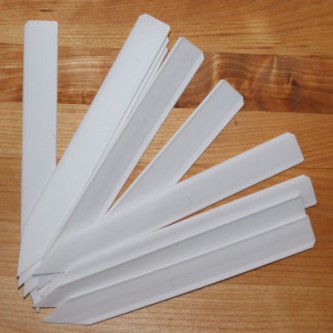Beefsteak tomato Costoluto Genovese is an organically grown beefsteak tomato variety. This ancient Italian variety originates from the Piedmont region north-west of the city of Genoa and Costoluto means ribbed. So this is a ribbed beefsteak tomato from the city of Genoa (Genovese). And that's exactly right because this smaller beefsteak tomatoes are very heavily ribbed. This tomato variety is very similar to the other Costoluto varieties such as: Costoluto Fiorentio or Costoluto Cantanese. The tomatoes can weigh on average between 75 - 200 grams each. They grow to between 7 - 8 cm in diameter. So they are somewhat small beefsteak tomatoes. The tomatoes ripen from green to bright red. This variety is an early variety that ripens quickly. The strong plants produce an average of 10 - 22 tomatoes each. So this is a good yield for a beefsteak tomato. The flavour is a characteristic old-fashioned tomato flavour with some sweetness and a little characteristic tomato acidity. The great-tasting and fragrant flesh is wonderfully firm, juicy and for such a reasonably small beefsteak tomato, the tomato contains a lot of flesh. The tomatoes contain few seeds. This variety of beefsteak tomato is very popular and not least by the Italians themselves. This tomato is also called Casalino. Beefsteak tomato Costoluto Genovese has a good resistance to diseases.
Use these tomatoes in pasta sauces, salads, in soups, ketchup, as stuffed tomatoes, on bread and in other dishes in which you use tomatoes. Ensure plenty of sun and warmth and support the plant well for best results.Tomatoes are high in vitamin C and lycopene. This is best absorbed into the body when tomatoes have been heated. Non hardy annual. Height: 100 - 180 cm.
Indoor sowing: February - April
Germination: 6 - 14 days
Germination temp: 20 - 25 °C
Sowing depth: 2 - 3 mm
Transplanting: when the seedlings are about 20 cm tall
Transplanting in garden: in May, after the last night frosts
Plant spacing: 45 - 50 cm
Planting position: sunny - sheltered (greenhouse)
Days till harvest: 60 - 90
Sow indoors from February on in trays filled with moist pottingsoil. Sow shallow and press the seeds gently in the soil, don't cover them with soil, because tomatoes are light germinators. Put the trays away somewhere warm at 20 - 25 °C and cover them with clingfilm or a lid. Keep the temperature as even as possible and don't let the temperature drop during the night. Keep moist, but not to wet to prevent rotting of the seeds. Remove the clingfilm or lid when the seedlings emerge. Transplant the seedlings to seperate pots approx. 10 days after emerging. Put them away a bit cooler at approx. 18 - 20 °C.
Harden the tomatoes of, from the middle of May, when there's no longer any danger of nightfrosts. Put the pots at a temperature of 15 - 18 °C for a week and reduce the amount of water for this week. Put the plants outdoors after this week on a sunny and sheltered plot with well draining soil or put them in a greenhouse. Make sure that there is no longer any nightfrost.
Tomatoes need some maintenance to ensure a good harvest. Give the plants a sturdy support with some sturdy and large bamboo sticks. Remove all suckers that will form in the axils of your plants. Remove all the leaves below the lowest hanging fruits by the end of July till the beginning of August. Remove all the leaves of all plants together with the tops of all plants from the end of August till the beginning of September to ensure the ripening of most of the green tomatoes. Harvest the tomatoes by cutting them with scissors. Tomatoes can't be kept for a long period. Don't keep your harvested tomatoes in the fridge. So use them a soon as possible after harvesting. Tomatoes used in sauces can be kept frozen to store.









